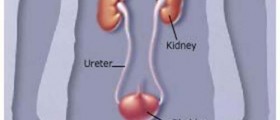
Congenital adrenal hyperplasia is a term that refers to several illnesses associated with mutations of genes in charge with production of cortisol from cholesterol by the adrenal glands. Deficiency of 21-hydroxylase is reported in around 95% of patients suffering from congenital adrenal hyperplasia. In majority of these illnesses there is evident problem with proper production of sex steroids. This consequently affects development of primary and secondary sex characteristic.
Insufficient production of glucocorticoids, particularly cortisol, reflects in increased production of ACTH. Furthermore, lack of mineralocorticoids (aldosterone) results in sodium and water imbalance. The actual cause of congenital adrenal hyperplasia has not been identified yet.
Symptoms of Congenital Adrenal Hyperplasia
In certain forms of the disease the production of androgen, a hormone that stimulates development and activity of male sew organs, is significantly increased. This causes serious abnormalities in sexual development and may be the most prominent characteristic of the disease. Increased levels of androgen particularly affect female patients and may cause masculinization of their external genitalia.
Insufficient production of glucocorticoids features with symptoms of Addison's disease. These patients are typically weak, anorexic, irritable and depressed. There is also nausea, vomiting, dark pigmentation of the skin, hypotension and lack of resistance to cold and improper physiological respond to stress. Insufficient production of aldosterone causes reduction in sodium levels, dehydration and circulatory collapse.
In case of congenital lipoid hyperplasia the leading characteristic is male pseudohermaphroditism. Namely, the external male genitalia fail to masculinize properly. There is also hypospadia.
Still the most frequent form of congenital adrenal hyperplasia is female pseudohermaphroditism. Female patients are actually born with noticeable abnormalities of the external genitalia. These abnormalities may be mild (clitoromegaly) or severe such as fusion of labia. This may cause confusion and a child may be considered male with a phallus and undescended testicles. However, female reproductive organs are placed inside the pelvis. These patients are usually raised as boys. If left untreated female patients will never menstruate and are prone to infertility. There is also developmental retardation and many physiological problems.
Male infants usually appear healthy and normal. Still, at the age of 3 or 4 the symptoms of congenital hyperplasia become more obvious. They include rapid growth, deepening of the voice, acne, enlargement of penis and growth of pubic and underarm hair. Normal puberty as well as testicular and sperm development is significantly affected.
Treatment for Congenital Adrenal Hyperplasia
These children must be supplied with adequate amount of glucocortiocoid. Proper treatment reduces hyperplasia and excessive production of androgens and mineralocorticoids. Furthermore, if there is a deficiency of mineralocorticoid or salt suitable replacement is required. Patients with insufficient amount of testosterone or estrogen during puberty are also provided with proper substitution. And there are additional treatments which optimize the growth and postpone premature puberty and bone maturation.
Patients with abnormal genital structure undergo reconstructive surgical procedures.

















Your thoughts on this
Loading...